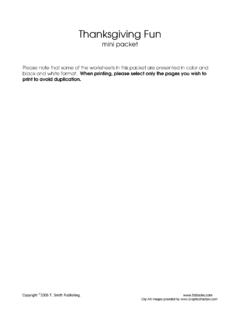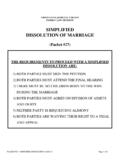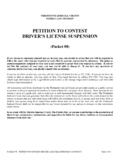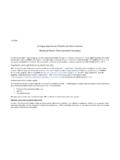Transcription of EASY TO CHEW RECIPES -2011 - bccancer.bc.ca
1 This information is not meant to replace the medical counsel of your doctor or individual consultation with a registered dietitian. This information may only be used in its entirety. Authorization given to reproduce this information with acknowledgement to Oncology Nutrition, BC Cancer Agency Revised July 2011, Updated October 2017 o:\bcca\docs\nutrition\patient education committee\originals\4. difficulty chewing or swallowing\easy to chew RECIPES Easy to chew RECIPES A soft, blenderized diet is the best way to continue to eat nutritious, tasty foods when chewing and/or swallowing become difficult. This booklet is designed to provide you with food ideas and RECIPES for soft and blenderized foods. Most of the RECIPES in this booklet can be served to your family, with only your portion needing to be blended or processed.
2 If you have any questions or concerns about your food choices, ability to eat, taste changes, weight loss, or any other nutrition issues, please contact your dietitian. EATING TIPS Make eating easier & more enjoyable: Relax and eat slowly. Help stimulate your appetite by improving the appearance of your food with garnishes. Use brightly coloured foods and attractive serving dishes. Eat small, frequent meals and consult your dietitian, if your appetite is poor. Gaining or maintaining weight: Eat smaller meals, more often. Melt grated cheese into warm sauces, soups and casseroles. Add skim milk powder into creamy dishes without affecting taste or volume. Add canned or pur ed meat/poultry, flaked fish, baby meat/poultry, finely chopped cooked egg or beaten egg to soups and sauces while cooking.
3 Put oatmeal, rice, barley, noodles or other cereal foods into soups, casseroles and combination dishes. Melt extra butter and/or margarine on warm food like potatoes, rice, hot cereal, vegetables, soup, etc. (Fat also improves the texture of most blended foods.) Add sour cream, whipping cream, salad dressings and/or gravy to give extra flavour and calories. Use homogenized whole milk (4% mf) or cream. Use brown sugar, honey, maple syrup and jelly to sweeten drinks, desserts and vegetables. This information is not meant to replace the medical counsel of your doctor or individual consultation with a registered dietitian. This information may only be used in its given to reproduce this information with acknowledgement to Oncology Nutrition, BC Cancer Agency Revised July 2011, Updated October 2017 2 Seasoning: Seasonings can be used to enhance the flavour of your meal, but they should be only used as tolerated.
4 Red Meats: chili powder, fresh parsley, onion, thyme, pepper, bay leaf, garlic, ginger, hot pepper sauce ( Tabasco ), Worcestershire sauce Poultry and Fish: bay leaf, lemon juice, rosemary, curry, paprika, sage, ginger Egg Dishes: pepper, dry mustard, paprika, curry, chives, thyme, basil Stews and Casseroles: sage, bay leaf, basil, cloves, curry, cumin, rosemary, ginger, hot pepper sauce ( Tabasco ), Worcestershire sauce Rice: saffron or turmeric before boiling Noodles: dill, parsley Vegetables: chives, curry , garlic, lemon juice, marjoram, thyme, fresh mint Tomato Sauces: oregano, parsley, basil Cream Sauces: parsley, tarragon, dill, curry powder Using Eggs: Do not eat or drink foods if they contain uncooked eggs. Increase the protein content of beverages by using pasteurized egg products ( Egg Beaters - found in grocers freezer, Simply Egg Whites , Just Egg Whites , -found with whole eggs in grocery store).
5 Buy refrigerated eggs from a reliable source. Do not use cracked eggs. Blending Tips Read instructions in the equipment manual for your blender. Cook foods in liquids such as broth, gravy, cream soup and sauces to help soften them Cut food into bite size pieces before blending. Put liquids in blender before solids. Blend a small amount of food at a time ( 1 cup). Too much food in the blender will not mix properly. Add enough liquid when blending. See the chart below for general guidelines add more liquid or solids to achieve the correct texture for you. To maintain eye appeal, try to avoid blending the entire meal together blend meat and vegetables/fruit separately. This information is not meant to replace the medical counsel of your doctor or individual consultation with a registered dietitian.
6 This information may only be used in its given to reproduce this information with acknowledgement to Oncology Nutrition, BC Cancer Agency Revised July 2011, Updated October 2017 3 Table Recommended Quantities of Food and Liquid for Blending TYPE OF FOOD AMOUNT OF FOOD SUGGESTED LIQUID AMOUNT OF LIQUID Meat or poultry (cooked) 250 ml (1 cup) Gravy, cream sauce, or broth 180 ml (3/4 cup) Vegetables (cooked with skins & seeds removed, or canned) 250 ml (1 cup) Gravy, cream sauce, vegetable/tomato juice, or broth 45 90 ml (3-6 Tbsp) Fruits (cooked with skins & seeds removed, or canned) 250 ml (1 cup) Cream, milk, yogurt, ice cream, juice, dessert tofu 30 60 ml (2-4 Tbsp) IMPORTANT: DO NOT OVER BLEND! (Over blending can result in a pasty product). Only remove the blender or processor container when the blade has come to a complete stop.
7 Never stir food contents while the blade is moving. Use hot soapy water to clean your blender after each use and check the underside of the blade for remaining food. Food Storage Tips 1. Store blended food in a covered container in the refrigerator no longer than 2 days. 2. Blended foods can be stored for longer periods in the freezer (2 to 3 months). 3. Air-tight containers, such as small plastic containers or muffin tins in sealed bags, can be used to store single portions. 4. To thaw food, put the single portion in the refrigerator. Table Recommended Types of Foods to Blend Type of Food Foods that Blend Well Foods that Don t Blend Well Milk and Milk Products All milk and milk beverages. Plain or flavoured yogurt. Yogurt or milk drinks with nuts or seeds Breads and Cereals Breads without nuts, seeds or dried fruits.
8 Cooked or ready to eat cereals. Pancakes french toast. Soft cooked rice, pasta. Coarse whole grain breads and cereals, granola. Fried rice and noodles This information is not meant to replace the medical counsel of your doctor or individual consultation with a registered dietitian. This information may only be used in its given to reproduce this information with acknowledgement to Oncology Nutrition, BC Cancer Agency Revised July 2011, Updated October 2017 4 Meat, Fish, Poultry and Alternatives Cooked, tender meat, fish, poultry. Infant strained meats. Eggs. Cottage cheese, cream cheese, melted cheese. Cooked legumes (beans, peas or lentils). Tofu. Smooth peanut butter. Fried meats. Sausages with tough skins. Skin of poultry, fish with bones. Fried eggs. Nuts. Fruits and vegetables All cooked or canned fruits and vegetables without skins or seeds.
9 Fresh peeled apples, bananas, melons, etc. Fruit and vegetable juices. Fruits and vegetables with seeds, membranes or tough skins ( strawberries, watermelon, tomatoes, oranges, celery, corn). Dried fruit, potato skin Soups Bouillon, consomm . All blended, strained stock or cream soups. None. Fats and Oils Margarine, butter, melted fats, oils, mayonnaise. Smooth sauces or gravies. None. Desserts and Sweets Smooth milk or gelatin desserts. Sugar, jellies, seedless jams, honey, syrups. Desserts or baked goods with nuts or seeds, coconut or chocolate chips etc. Marmalade. Beverages All. Those made with foods that don t blend or strain well Other Ground spices or herbs. Tomato paste. Mustard, tomato catsup and other smooth condiments. Nuts, coconut, seeds. Popcorn. Chocolate chips. Relishes. Imperial and Metric Conversion Table cup = 50 mL 1 cup = 250 mL 1/3 cup = 75 mL 1 teaspoon (tsp) = 5 mL cup = 125 mL 1 tablespoon (Tbsp) =15 mL 2/3 cup = 175 mL 1 fluid ounce (oz) = 30 mL cup = 200 mL This information is not meant to replace the medical counsel of your doctor or individual consultation with a registered dietitian.
10 This information may only be used in its given to reproduce this information with acknowledgement to Oncology Nutrition, BC Cancer Agency Revised July 2011, Updated October 2017 5 SAMPLE MENUS Three Meals a day Morning cup fruit juice 1 serving Easy Cheesy Eggs* 1 cup hot chocolate Noon 1 cup macaroni and cheese cup pureed green beans 1 cup whole milk 2-3 digestive cookies (dunked in milk) cup pureed apricot (canned, blended with syrup) Evening cup cream of mushroom soup 3 oz blenderized chicken 4 tbsp chicken gravy cup mashed potatoes cup pureed carrots 1 tbsp butter cup custard* Six Small Meals Morning cup High Protein Cereal* 3 oz. cream 1 sugar cup fruit juice Mid-morning 1 cup eggnog* Noon cup vegetable beef soup* 4 soda crackers Mid-afternoon 1 soft sliced banana 3 oz.
















